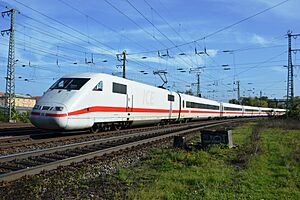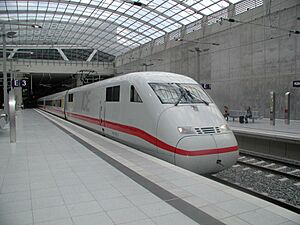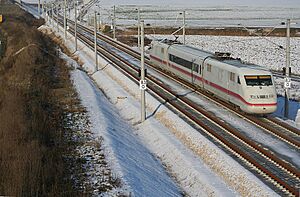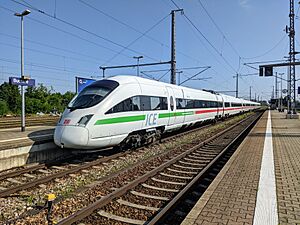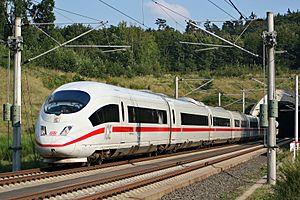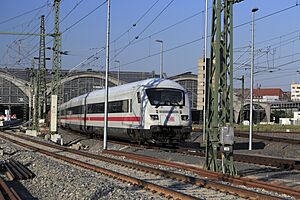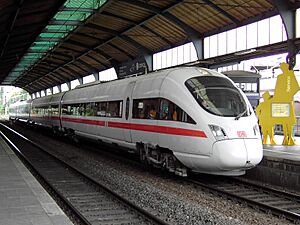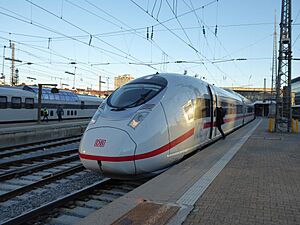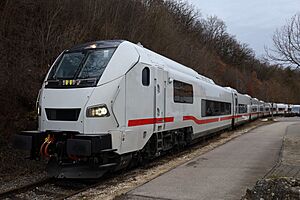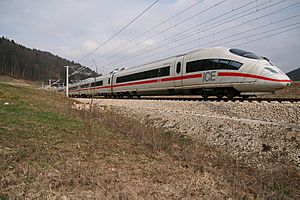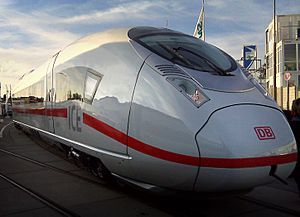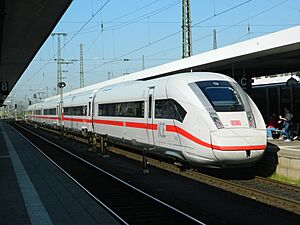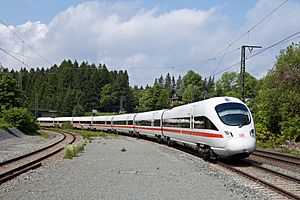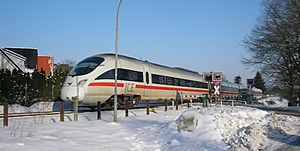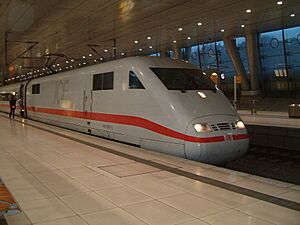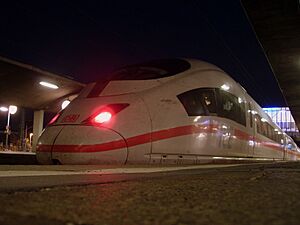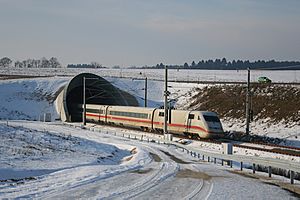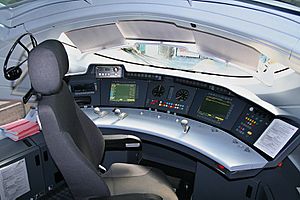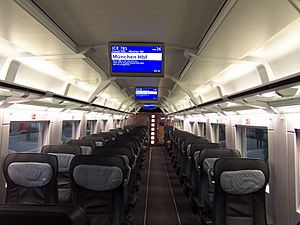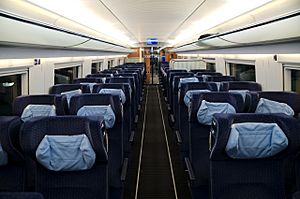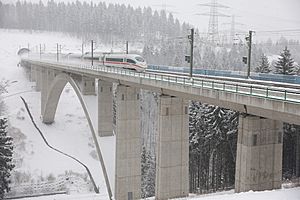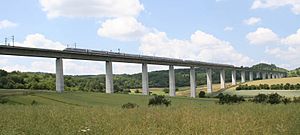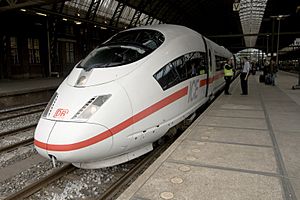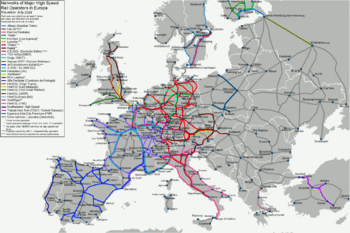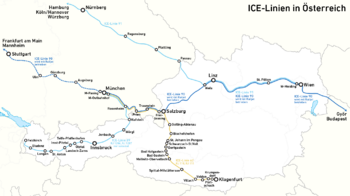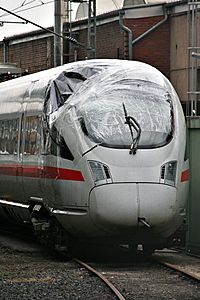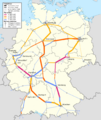Intercity Express facts for kids
 |
|
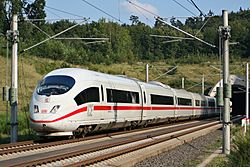
A German ICE 3 trainset exiting a tunnel
|
|
| Overview | |
|---|---|
| Locale | Germany, Netherlands, Belgium, Austria, Switzerland and France. Formerly Denmark. |
| Dates of operation | 1985–present |
| Predecessor | See History |
| Technical | |
| Track gauge | 1,435 mm (4 ft 8 1⁄2 in) standard gauge |
The Intercity Express (often called ICE) is Germany's super-fast train system. These trains are the main way Deutsche Bahn (Germany's national railway company) offers long-distance travel. ICE trains also travel to other countries like Austria, France, Belgium, Switzerland, and the Netherlands.
ICE trains are designed for comfort and speed. They can travel up to 300 kilometers per hour (about 186 miles per hour) in Germany and 320 km/h (about 199 mph) in France. They are a popular choice for business travelers and people traveling long distances, offering a quick alternative to flying. The Siemens Velaro family of trains, used in many countries, was developed from the ICE 3 design.
Contents
History of ICE Trains
The story of ICE trains began in 1985. The Deutsche Bundesbahn (the railway company at the time) started testing a special train called the InterCityExperimental (also known as ICE-V). This test train was used to show off new technology and set speed records. On May 1, 1988, it set a new world speed record for trains, reaching 406.9 km/h (253 mph)! This train was retired in 1996 and replaced by another test unit, the ICE S.
After a lot of planning, the first 41 ICE trains were ordered in 1988. More trains were ordered in 1990. The official ICE network started on May 29, 1991. Several ICE trains met at the new Kassel-Wilhelmshöhe station from different directions to celebrate. In 2007, a new high-speed line opened between Paris and Frankfurt/Stuttgart, with ICE and French TGV trains running on it together.
Types of ICE Trains
Overview of ICE Models
Here's a quick look at the different types of ICE trains:
First Generation: ICE 1
The first ICE trains were the ICE 1 models, which started service in 1989. Regular ICE trains began running on June 2, 1991, connecting major cities like Hamburg, Hanover, Frankfurt, and Munich. These trains quickly became part of Germany's new high-speed rail lines.
Second Generation: ICE 2

Starting in 1997, the ICE 2 trains began service. A key goal for the ICE 2 was to make trains more flexible. These trains could be split or joined together as needed. This helped balance the number of passengers on different parts of a journey.
The ICE 2 trains were used on the Berlin-Cologne/Bonn line. In late 1998, the Hanover–Berlin high-speed railway opened. This new line cut travel time between Berlin and the Ruhr valley by 2.5 hours.
Both ICE 1 and ICE 2 trains are quite wide. This means they mostly run in Germany, Austria, and Switzerland. Some ICE 1 trains even have a special smaller part on their roof (called a pantograph) to work with Switzerland's different power lines. ICE 2 trains can reach speeds of 280 km/h (174 mph).
Third Generation: ICE 3
The ICE 3 trains were designed to travel across more of Europe. They are narrower than earlier ICE models. Unlike older trains that have separate engines, ICE 3 trains have motors spread out under the whole train. This design makes them lighter and helps them meet international railway standards.
There are different types of ICE 3 trains. The Class 403 is for domestic travel, while the Class 406 (ICE 3M) can run on different power systems in various countries. Later came Class 407 and Class 408. The company that makes them, Siemens, calls them "Velaro."
Like the ICE 2, ICE 3 trains can be coupled together. They are the only ICE trains that can handle the steep hills on the Cologne–Frankfurt high-speed rail line at top speed (300 km/h). This is why they are mainly used on routes that include this line.
In 2009, Deutsche Bahn ordered 16 more ICE 3 trains for international travel, especially to France. The Erfurt–Leipzig/Halle high-speed railway, which opened in December 2015, is another line where ICE 3 trains can reach 300 km/h. ICE 3 trains can even go up to 320 km/h (199 mph) on the LGV Est railway in France.
The newest ICE 3 version, Class 407 (Velaro D), runs on many routes in Germany and to other countries like France. Deutsche Bahn ordered 90 more of these trains, called ICE 3neo (Class 408), starting in 2020. These trains are designed for 320 km/h and began service in late 2022. The Class 406 trains were retired from service in April 2025.
Fourth Generation: ICE 4
The ICE 4 trains were planned around 2008 to replace older trains. In 2011, Siemens won the contract to build them. The trains were first called ICx during development. In late 2015, they were officially named ICE 4 and given the class number 412. These trains are now all in service.
ICE T and ICE TD
At the same time as the ICE 3, Siemens also developed trains with a special "tilting" technology. These are the ICE T (electric) and ICE TD (diesel) trains. Tilting trains can lean into curves, allowing them to go faster on older, winding railway lines. They have a similar look to the ICE 3 trains.
ICE T
A total of 71 ICE T trains were built. The "T" in ICE T originally stood for Triebwagen (railcar), not "tilting." This was because their top speed of 230 km/h (143 mph) was initially thought to be too slow for the "InterCityExpress" brand. Austria's ÖBB bought three of these trains in 2007. The 5-car Class 415 ICE T trains are being gradually retired starting in June 2025.
ICE TD
Deutsche Bahn ordered 20 diesel-powered ICE-T trains in 2001, called Class 605 ICE-TD. These trains were meant for routes without electric power lines. However, they had many technical problems and were expensive to run because of high diesel fuel taxes in Germany. They were taken out of regular service soon after delivery.
For a while, ICE-TD trains were used for routes between Hamburg and Copenhagen, and Hamburg and Aarhus. This was because the Danish railway network was not fully electric. However, Deutsche Bahn retired the entire ICE TD fleet in 2018.
Differences in Train Designs
Here are some ways to tell the different ICE trains apart:
- ICE (in general): They are usually light grey with a red stripe. They have black window bands and oval door windows (except ICE 4). They run on wheels on rails, unlike the Transrapid maglev train.
- ICE 1: Has two power cars (engines) and up to 14 passenger cars. The restaurant car has a high roof. The nose has the DB logo that breaks the red stripe. Max speed is 280 km/h (174 mph).
- ICE 2: Has one power car and one control car (a passenger car with a driver's cabin). The restaurant/bistro car is the same height as other cars. The nose can open up to show the coupler. Max speed is 280 km/h (174 mph).
- ICE 3: No separate power cars; motors are under the whole train (an electric multiple unit). The end cars have a rounded front and a passenger lounge. Max speed is 320 km/h (199 mph). The red stripe goes down and across the nose.
- ICE 4: No separate power cars. Max speed is 265 km/h (165 mph). It does not have oval door windows. The red stripe goes down and across the nose.
- ICE T/ICE TD: Looks similar to ICE 3 but has a steeper front. ICE T has a pantograph on the roof. ICE T max speed is 230 km/h (143 mph). ICE TD max speed is 200 km/h (124 mph). The red stripe stays straight.
- ICE T2: Similar to ICE T, but has painted metal instead of glass between windows and LED front lights.
- ICE V: This was the test train. It was violet with a wide stripe.
- ICE S: Another test train. It has an "S" next to the ICE logo. Most have only one passenger car. Max speed is 330 km/h (205 mph).
Train Colors and Design
The ICE trains have a very recognizable look. They are painted in a light grey color with a bright red stripe along the bottom. The black band of windows and their oval door windows (on most models) make them stand out from other German trains.
The first ICE 1 and ICE 2 trains had a slightly different red stripe and a pastel violet stripe. These were repainted to the current bright red between 1998 and 2000. The "ICE" letters are grey, and the frame is a darker grey. The inside of the trains is mostly light grey.
The original ICE 1 interiors were mint green. However, they were updated between 2005 and 2008 to look more like the ICE 3, with more indirect lighting and wood. The unique ICE design was created by a team led by Alexander Neumeister in the early 1980s.
Trainset Numbers
Each car in an ICE train has its own unique number. However, trains usually stay coupled together as fixed sets for many years. To make it easier to identify them, each set has a "trainset number" printed on it. These numbers often match the numbers of the power cars or driver cars.
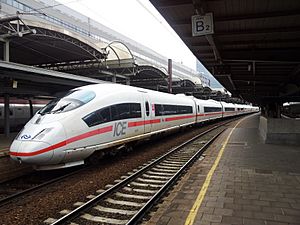
| ICE 1: | Tz 01 to 20 (older motors) | Tz 51 to 71 (newer motors) | Tz 72 to 90 (for Switzerland) | |
| ICE 2: | Tz 201 to 244 | |||
| ICE 3: | Tz 301 to 337 (first series) | Tz 351 to 367 (second series) | ||
| ICE 3M: | Tz 4601 to 4613 (7 sets) | Tz 4651 to 4654 (owned by Nederlandse Spoorwegen (NS)) | ||
| ICE 3MF: | Tz 4680 to 4684 (for France) | Tz 4685 (for France and UK) | ||
| ICE T: | Tz 1101 to 1132 (first series, 7 cars) | Tz 1151 to 1178 (second series, 7 cars) | Tz 1180 to 1184 (for Switzerland) | Tz 1190 to 1192 (sold to ÖBB) |
| ICE T: | Tz 1501 to 1506 (5 cars) | Tz 1520 to 1524 (5 cars, originally for Switzerland) | ||
| ICE TD: | Tz 5501 to 5520 |
Inside the ICE Trains
ICE trains are very modern inside. All cars have air conditioning. Many seats have headphone jacks so you can listen to music or radio. Some first-class seats even have screens for movies. There are special "quiet zones" where people are asked not to use their phones. Newer ICE 3 trains have large digital screens showing ads, arrival times, and the train's current speed.
Older ICE 1 trains were updated between 2005 and 2008. They got new seats, electric sockets at every seat, and electronic seat reservation displays. ICE 2 trains have been updated since 2010. ICE 3 and ICE T trains have sockets at almost every seat.
ICE 1, ICE 2, and the 7-car ICE T trains have full restaurant cars. The 5-car ICE T and ICE 3 trains have a bistro car instead. Smoking has been banned in all restaurant and bistro cars since October 2006.
All ICE trains have a toilet for disabled passengers and spaces for wheelchairs. ICE 1 and ICE 2 have a special meeting room. ICE 3 trains have a special area for small children. Instead of a closed office for the train manager, ICE 3 and ICE T trains have an open "ServicePoint."
An electronic display above each seat shows if the seat is reserved and for which part of the journey. If the display is blank, the seat is free.
Train Maintenance
ICE trains are regularly checked and maintained to keep them safe and running smoothly. This happens in seven steps:
- Every 4,000 kilometers (about 2,500 miles), a 1.5-hour check is done. They empty waste, refill water, fix small problems, and check safety features like the wheels and power collectors on the roof.
- Every 20,000 kilometers (about 12,400 miles), a 2.5-hour check called Nachschau is done. They check the brakes and other safety systems.
- After 80,000 kilometers (about 50,000 miles), a deeper check called Inspektionsstufe 1 happens. This takes 8 hours and includes checking the air conditioning and kitchen.
- At 240,000 kilometers (about 150,000 miles), Inspektionsstufe 2 checks the motors, bearings, and couplers. This also takes 8 hours.
- About once a year (at 480,000 km or 300,000 miles), Inspektionsstufe 3 takes place, lasting 24 hours. They check the air systems and transformer cooling.
- The 1st Revision is done after 1.2 million km (about 745,000 miles). This is a very thorough check of all parts, taking two 5-day periods.
- The final step, the 2nd Revision, happens at 2.4 million kilometers (about 1.5 million miles). The train's wheel sets are replaced, and many parts are taken apart and checked. This also takes two 5-day periods.
Maintenance is done in special ICE workshops in cities like Frankfurt, Hamburg, and Munich. The train's computer system sends reports ahead of time to help the workers.
ICE Routes
The ICE system is a network of lines that connect many cities. Trains run every 30 minutes, every hour, or every two hours. During busy times, extra trains are added.
Unlike some other high-speed systems, ICE trains use Germany's existing railway lines. This means ICE 3 trains can only reach their top speed of 300 km/h (186 mph) on certain parts of the lines. They can reach 320 km/h in France.
The busiest line for ICE trains is between Frankfurt and Mannheim. The busiest line overall that carries ICE traffic is the Munich–Augsburg line, with about 300 trains per day.
Main North-South Connections
The ICE network has six main lines running from north to south:
- From Hamburg to Basel (Switzerland) or Stuttgart.
- From Hamburg or Bremen to Munich.
- From Hamburg or Berlin to Munich or Stuttgart.
- From Berlin to Basel or Frankfurt Airport.
- From Amsterdam (Netherlands) or Dortmund to Basel or Munich.
- From Essen to Munich.
Main East-West Connections
There are three main lines running from east to west:
- From Berlin to Cologne/Bonn Airport or Cologne.
- From Dresden to Wiesbaden.
- From Karlsruhe to Munich.
German Branch Lines
Some ICE lines also extend to other cities:
- From Berlin to Rostock or Stralsund.
- From Hamburg to Lübeck or Kiel.
- From Bremen to Oldenburg.
- From Leipzig to Cologne or Düsseldorf.
- From Würzburg to Essen.
- From Munich to Garmisch-Partenkirchen.
- From Nuremberg to Passau.
ICE Sprinter Trains
"ICE Sprinter" trains are special services with fewer stops between major German cities. They run in the morning and evening, mainly for business travelers. They are usually about 30 minutes faster than regular ICE trains on the same routes.
A reservation used to be required for ICE Sprinter trains, but this changed in December 2015. The first Sprinter service started between Munich and Frankfurt in 1992.
As of 2018, here are some ICE Sprinter lines:
| No. | Departure station | Intermediate stops | Destination | Travel time (hh:mm) | Time of day |
|---|---|---|---|---|---|
| 11 13 17 19 121 123 125 127 129 211 215 221 |
Köln Hbf | Frankfurt Airport | Frankfurt (Main) Hbf | 1:01 1:02 1:03 1:06 |
Morning Noon Afternoon Evening Night |
| 14 16 120 124 126 128 210 220 |
Frankfurt (Main) Hbf | Frankfurt Airport | Köln Hbf | 1:06 1:04 1:10 |
Morning Noon Evening |
| 591 593 595 597 599 691 695 |
Frankfurt (Main) Hbf | Mannheim Hbf | Stuttgart Hbf | 1:18 | Morning Noon Afternoon Evening |
| 590 592 594 598 690 692 694 |
Stuttgart Hbf | Mannheim Hbf | Frankfurt (Main) Hbf | 1:17 | Morning Noon Afternoon Evening |
| 1000 1004 1008 |
München Hbf | Nuremberg Hbf, Erfurt Hbf, Halle (Saale) Hbf, Berlin Südkreuz | Berlin Hbf | 3:55 | Morning Noon Evening |
| 1001 1005 1009 |
Berlin Hbf | Berlin Südkreuz, Halle (Saale) Hbf, Erfurt Hbf, Nuremberg Hbf | München Hbf | 4:02 3:58 |
Morning Noon Evening |
| 1031 | Hamburg Hbf | Essen Hbf, Duisburg Hbf, Düsseldorf Hbf | Köln Hbf | 3:35 | Morning |
| 1038 | Köln Hbf | Düsseldorf Hbf, Duisburg Hbf, Essen Hbf | Hamburg Hbf | 3:38 | Morning |
| 1094 | Frankfurt Hbf | Hannover Hbf | Hamburg Hbf | 3:26 | Afternoon |
| 1097 | Hamburg-Altona | Hamburg Hbf, Hamburg Dammtor, Hannover Hbf | Frankfurt Hbf | 3:20 | Morning |
| 1533 1535 1598 1631 1633 |
Frankfurt (Main) Hbf | Erfurt Hbf, Halle (Saale) Hbf, Berlin Südkreuz | Berlin Hbf | 3:56 3:53 |
Morning Noon Afternoon Evening |
| 1536 1538 1636 1638 |
Berlin Hbf | Berlin Südkreuz, Halle (Saale) Hbf, Erfurt Hbf | Frankfurt (Main) Hbf | 3:52 3:54 |
Morning Noon Afternoon Evening |
International ICE Routes
Some ICE trains also travel to other countries:
- From Frankfurt to Amsterdam (Netherlands).
- From Frankfurt to Brussels (Belgium).
- From Frankfurt or Stuttgart to Paris (France).
- From Hamburg or Berlin to Basel or Zurich (Switzerland).
- From Frankfurt or Dortmund to Vienna (Austria).
- From Dortmund to Innsbruck (Austria).
- From Berlin to Paris (France) (started December 2024).
- From Münster to Klagenfurt (Austria).
- From Amsterdam to Basel (Switzerland).
- From Munich to Zurich (Switzerland) (operated by Swiss Federal Railways).
Since December 2006, ICE 3M trains have run between Frankfurt and Paris. This line is part of a larger European high-speed network.
There were plans for ICE trains to travel to London through the Channel Tunnel. However, due to safety rules for the tunnel and other issues, these plans have been delayed. As of 2025, Eurostar also plans to launch direct train services between London and Frankfurt.
ICE Trains within Switzerland
To make sure trains are used efficiently, some ICE services run only within Switzerland. These trains travel between cities like Basel, Zurich, and Interlaken. Even though they are called ICEs, they are more like regular Swiss regional trains and can be used without extra fees.
Accidents Involving ICE Trains
There have been several accidents with ICE trains. The Eschede disaster was the only one with deaths inside the train. Other accidents have caused major damage to the trains.
The Eschede Disaster
The ICE accident near Eschede on June 3, 1998, was a very serious train accident. Trainset 51, traveling from Munich to Hamburg, derailed at 200 km/h (124 mph). This accident killed 101 people and injured 88. It is the worst high-speed rail disaster in the world.
The accident happened because a wheel rim broke. This damaged the train and the tracks. The train then hit a bridge, which collapsed onto the tracks. Only the front part of the train passed under the bridge; the rest crashed into the collapsed bridge.
Other Accidents
- On September 27, 2001, trainset 5509 fell off a work platform and was too damaged to be used again.
- On November 22, 2001, a power car (engine) caught fire in Offenbach am Main. No one was hurt, but the power car was destroyed.
- On January 6, 2004, an ICE TD trainset caught fire in Leipzig. Two cars were destroyed.
- On April 1, 2004, trainset 321 hit a tractor that had fallen onto the track and derailed. No one was injured.
- On April 28, 2006, trainset 73 collided with two locomotives in Thun, Switzerland. The ICE was going 56 km/h (35 mph) at impact. 30 passengers and the ICE driver had minor injuries. Both trains were badly damaged.
- On March 1, 2008, trainset 1192 hit a tree that had fallen onto the track near Brühl during a storm. The driver was seriously injured.
- On April 26, 2008, trainset 11 hit a herd of sheep near Fulda. Both power cars and ten of the 12 passenger cars derailed. 19 passengers had minor injuries.
- In July 2008, a cracked axle caused a low-speed derailment in Cologne. No one was hurt, but it led to checks of other ICE trains.
- On April 17, 2010, an ICE train lost a door while traveling at high speed. The door hit another ICE train on a nearby track, injuring six people.
- On August 17, 2010, an ICE train hit a truck that had slid onto the tracks. The first two cars derailed, and ten people were injured.
- On January 11, 2011, trainset 4654 partly derailed after hitting a freight train in the Netherlands. No one was injured.
- On May 2, 2017, a trainset derailed at Dortmund Hauptbahnhof, injuring two people.
- On October 12, 2018, two cars of a trainset caught fire. Five people had minor injuries during the evacuation.
Ticket Prices
Germany
ICE trains are the highest category of trains in Germany. Their ticket prices are fixed for each journey, not based on how many kilometers you travel. The price depends on things like the route and how popular the line is. Even on lines where an ICE train isn't faster than a regular IC train, you pay extra because ICE trains offer more comfort.
Austria and Switzerland
On ICE trains traveling within Austria or Switzerland, you usually don't have to pay extra fees.
Netherlands
For ICE trains between Amsterdam and Cologne, if you travel only within the Netherlands, you can use your national public transport card but need to buy a small extra ticket. If you travel to or from Germany, you need an international ticket.
France
For ICE trains between Paris and Frankfurt or Stuttgart, you must reserve a seat for trips to or within France.
Ridership
| Ridership | ||
|---|---|---|
| Year | million riders | ±% p.a. |
| 1991 | 5.1 | — |
| 1992 | 10.2 | +100.00% |
| 1993 | 14.6 | +43.14% |
| 1994 | 21.3 | +45.89% |
| 1995 | 27.2 | +27.70% |
| 2000 | 41.6 | +8.87% |
| 2005 | 66.8 | +9.94% |
| 2010 | 77.8 | +3.10% |
| 2015 | 80 | +0.56% |
| 2018 | 94 | +5.52% |
| 2019 | 99.2 | +5.53% |
From its start in July 1991 until 2006, ICE trains carried about 550 million passengers. In 2005 alone, 67 million people rode ICE trains. By 2015, the total number of passengers carried was about 1.25 billion!
Legacy and Models
On October 5, 2006, the German postal service released a stamp featuring an ICE 3 train. Lego also made a train set modeled after the ICE. You can also find ICE trains in train simulator video games.
Images for kids
See also
 In Spanish: InterCityExpress para niños
In Spanish: InterCityExpress para niños
- List of Intercity-Express lines
- List of Intercity-Express railway stations
- High-speed rail in Europe
- AVE (Spain's high-speed train)
- TGV (France's high-speed train)
- Rail transport in Europe
- Train categories in Europe



